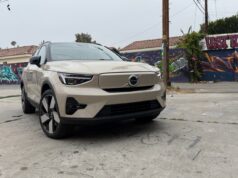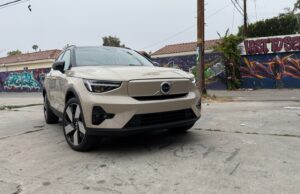Kia and its Hyundai cousin have launched the strongest assault yet against the Toyota Prius with the Niro and Ioniq hybrid models. While the Ioniq is a more direct aim at the Prius, the Kia Niro attempts to take a slightly different approach, well at least from a marketing perspective, since Kia’s team calls the Niro a crossover. Last year the Kia Niro hybrid launched to give crossover buyers a new efficient hybrid choice and now Kia has expanded it with the addition of the 2018 Niro Plug-in Hybrid.
The 2018 Kia Niro Plug-in Hybrid is Kia’s rival to the Toyota Prius Prime. The Niro Plug-in Hybrid is powered by the same 1.6L four-cylinder as the Niro Hybrid, which generates 104 horsepower and 109 lb-ft. The Niro Plug-in Hybrid does one up the hybrid model a bit with its more powerful electric motor (60-hp vs 43-hp). Both versions also send the power to the front wheels via a dual clutch six-speed automatic transmission. The Niro Plug-in Hybrid also has a larger battery than the Niro Hybrid (8.9 kWh vs 1.56 kWh).
Thanks to the larger battery, the Niro Plug-in Hybrid can travel up to 26 miles on electricity alone and once the battery is drained the Niro Plug-in Hybrid converts to a regular hybrid giving you a total 560 mile driving range. The Niro Plug-in hybrid is rated at 110/99 MPGe when the battery is charged or 48/44 mpg in hybrid mode. What’s interesting is that in hybrid mode, the Niro Plug-in Hybrid is actually less efficient than the Niro Hybrid with 16-inch wheels (48/44 mpg vs 51/46 mpg). The Niro Plug-in Hybrid’s extra weight from the larger battery is the likely culprit.
To compare the Toyota Prius Prime can travel up to 25 miles in EV mode and is rated at 133 MPGe. In hybrid mode the Prius Prime is more efficient than the Niro Plug-in Hybrid with a 55/53 mpg rating.
Even with an extra 200 pounds of weight to pull around, the Niro Plug-in Hybrid feels like it has a bit more oomph than the Niro Hybrid. The electric motor’s extra horsepower is one of the main reasons that the Niro Plug-in Hybrid is able to take off from a stop a few ticks faster. The extra weight from the battery also makes the Niro Plug-in Hybrid feel a bit more stable to the road than the standard Niro, with the only big let down being the eco friendly Michelin Energy Saver tires. The low grip from the tires makes it all too easy to spin the front wheels.
One nice feature is the Sport mode that is not too common on hybrids. The Sport mode improves the throttle and gear shift points to make the Niro Plug-in Hybrid feel a little more spirited. It’s too bad that the Niro Plug-in Hybrid doesn’t offer paddle shifters like the Ioniq Plug-in Hybrid.
With the battery charged up, the Niro Plug-in Hybrid can provide emissions free jaunts around the city, but push it hard and the gas engine will kick on, no matter how much the battery is charged. This can be a little daunting, but with only 60 horsepower coming from the electric motor, it’s not surprising that it needs the gas engine to help keep it moving. On a hot summer day or wintery night with the climate control on full blast, the gas engine will also switch on more.
If you are cross-shopping the Niro Plug-in Hybrid against the Prius Prime, there’s one big spec that might make it an easier decision. The Niro Plug-in Hybrid can fit five passengers, while the Prius Prime only has room for four. Both models have nearly the same cargo capacity with the Niro Plug-in Hybrid’s 19.4 cubic feet of space with the rear seat up compared to the Prius Prime’s 19.8 cubic feet. The Niro Plug-in Hybrid also has more rear legroom (37.4-inches vs 33.4-inches) and more rear headroom (39.1-inches vs 37.2-inches).
At the end of the day the Niro Plug-in Hybrid does have an electric driving range that is comparable to the Prius Prime, but it’s not as efficient. Does it make sense to buy the Niro Plug-in Hybrid over the standard Niro Hybrid? The Niro Plug-in Hybrid LX starts at $27,900, which is $4,250 more than the Niro Hybrid LX, which starts at $23,650. There are some federal and state tax credits that can help reduce the price differences between the two versions, but once those dry up, the Niro Plug-in Hybrid is a harder sell. In California there is one more added benefit, the Niro Plug-in Hybrid is eligible for single occupant carpool lane stickers, which will make your commute a little easier.




























